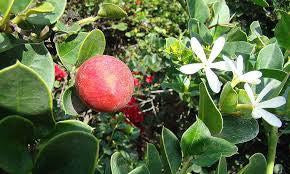
How To Care For Your Natal Plum Bonsai Tree
Carissa Macrocarpa Bonsai Care
About The Natal Plum Flower Bonsai Tree
A shrubby evergreen native to the tropics, the natal plum gets its name from it's tasty fruits that resemble a standard grocery store plum fruit.
The flowers are remarkably fragrant, and a unique star shape.
If you're lucky, your natal plum will produce edible fruits.
When placed outside in warm weather, this bonsai will attract butterflies and birds to the garden.
Placement
Like most tropical trees, a natal plum bonsai should remain indoors when the low temperatures reach 50 degrees F.
Make sure your natal plum tree gets at least 6 hours of quality sunlight while indoors, either through a grow light or a southern window. An eastern or western window sill would be sufficient, if it's giving 6+ hours of light.
In the summer, when the chance of dropping below 50 is gone, it can be placed outside for the season in high light.
Watering
Never let the soil completely dry out. Whenever the soil seems dry, thoroughly water your tree until the water runs clear from the bottom. In the growing season, this can be daily.
If you need help, a good moisture meter will guide you.
Humidity
If you ever need to take your natal plum bonsai tree inside, including into a garage for the winter, using a humidity tray is recommended. It will prevent the water from running on the floor, and can help keep the tree somewhat moist in the dry season.
Fertilizing
Since your natal plum bonsai is in a small pot, and not the ground, it needs nutrients. A slow release (pellet based) fertilizer is perfect for this, and can be added sparingly every 1-2 months during the growing season.
Pruning & Trimming
Trim back the new growth to the farthest safe point that looks good to you — but never remove all of the new growth.
A regular trim will help keep your natal plum bonsai tree short, while helping the trunk grow thicker.
Repotting
Repotting must be performed periodically on your bonsai, natal plum included, when its root system has filled the pot. If you can clearly see the roots coming out of the bottom of the pot, it’s time to repot your bonsai.
Generally, this means every 2-3 years for a deciduous tree and every 4-5 years for an evergreen or tropical.
Repotting should be done in mid-summer, when the tree is at it’s least fragile state.
The natal plum bonsai tree, along with all of its soil, should be removed from the pot. From there, you can trim away no more than 1/3rd of the root mass (1/4th is preferred.)
Then you can repot the tree in the same pot, or give it a newer / bigger pot to thrive in.
After repotting, your natal plum bonsai should be thoroughly watered.
Diseases, Insects & Other Pests
Your natal plum bonsai can be treated for pests like a normal natal plum plant. Just remember, your tree is miniature and will need a much smaller and more gentile dose of treatment.
If you're looking to buy a natal plum flower bonsai for your home or office, we offer the finest artisan selection available.
Would you like to SEE these instructions as a series of videos, instead of just reading them?
If you want to demystify the art of bonsai so you can become a master of this relaxing hobby in just a few days, you need the right training. I’ve built a digital video course that mixes classroom style instructional videos with “over the shoulder” style training videos to make bonsai simple to understand, and easy to start.
In this digital video course, you'll discover:
- How to create a bonsai tree from scratch that will help you experience true inner-peace and calm.
- How to keep your tree collection alive and well so you can enjoy their benefits for a lifetime.
- How to shape your bonsai like a professional, allowing you to design it however you like.
- What bonsai tools you really need and how to use them so you’ll never buy a tool that you don’t need again.
- How to cultivate your own trees so you never have to buy another tree from a store again.
- How to use all of this to create your own bonsai collection so you enjoy this relaxing hobby for the rest of your life.



